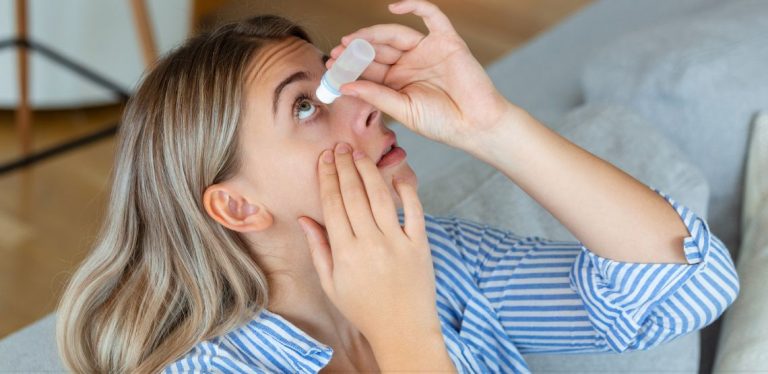Get Relief With These Options
A range of treatment options exists to address dry eyes, from simple home remedies to medical treatments like Restasis, a medication used to treat dry eye disease.
Restasis
Restasis works by reducing inflammation in the tear glands, which helps them produce more natural tears. Unlike artificial tears that provide temporary relief, Restasis targets the root cause of reduced tear production.
It is typically used twice daily and may take several weeks to show noticeable improvement. This treatment is especially helpful for people with dry eye caused by conditions like Sjögren's syndrome or other inflammatory disorders.
1. Prescription Eye Drops
Prescription medications are often recommended for chronic dry eyes. These medications typically address the root cause of chronic dry eyes, such as inflammation or low tear production.
- Xiidra (Lifitegrast): Xiidra is an FDA-approved eye drop designed to treat the symptoms of dry eyes by reducing inflammation. Xiidra blocks certain proteins that cause inflammation in the eye, offering relief and improving tear production. Users generally apply Xiidra twice daily, with many reporting relief within a few weeks. Although mild side effects, such as temporary burning or a metallic taste, may occur, Xiidra is a preferred choice for chronic cases.
- Miebo (Perfluorohexyloctane Ophthalmic Solution): Miebo targets the lipid (oil) layer to prevent tears from evaporating too quickly. Unlike many other dry eye treatments, Miebo directly addresses the cause of tear film instability associated with meibomian gland dysfunction, a common cause of dry eyes.
- Cequa (Cyclosporine A): Another prescription option, Cequa, works by increasing tear production and is commonly prescribed for those with chronic dry eye related to inflammation. Cequa is similar to Restasis but has a higher concentration of cyclosporine, making it an option for more severe cases. This drop is typically applied twice daily and provides relief over several weeks.
2. Hydrating Eye Drops and Sprays
Artificial tears are typically the first line of defense for dry eyes. Available over the counter, these drops mimic natural tears, providing temporary relief from dryness. Some people benefit more from thicker eye gels or ointments, which last longer, especially overnight. Additionally, eye sprays can be used on closed eyelids to provide hydration, especially for people sensitive to drops. These sprays are particularly useful for people with mild to moderate symptoms or those looking for a convenient, on-the-go solution.
3. Nutritional Supplements
Diet can play a key role in eye health, with omega-3 fatty acids being especially beneficial for dry eyes. Omega-3s, found in fish oil and flaxseed, help reduce inflammation and improve the quality of the tear film. People with dry eyes may benefit from adding an omega-3 supplement to their diet, or from eating more omega-3-rich foods like salmon, sardines and walnuts. In addition to omega-3s, other eye-friendly nutrients such as vitamins A, C and E can help maintain optimal eye health and may alleviate some symptoms.
4. Thermal Pulsation Treatment
Thermal pulsation devices, such as LipiFlow, are used to address meibomian gland dysfunction, a common cause of dry eyes. This in-office treatment uses gentle heat and pressure to unclog oil glands along the eyelid, helping maintain a stable tear film. By restoring oil flow, the treatment can reduce symptoms of dry eyes related to tear evaporation. LipiFlow is generally safe and effective, though it may need to be repeated over time to maintain results.
5. Intense Pulsed Light (IPL) Therapy
Intense pulsed light (IPL) therapy, commonly used for skin rejuvenation, has proven helpful for managing dry eyes caused by meibomian gland dysfunction. IPL reduces inflammation and improves gland function, enhancing tear film stability. Administered by an eye specialist, IPL therapy is performed as a series of sessions, with many patients experiencing long-lasting relief. While not suitable for everyone, it can be highly effective for those with chronic dry eyes due to gland dysfunction.
6. Moisture Goggles
For individuals with more severe symptoms or those in dry environments, moisture goggles can provide significant relief. These goggles trap moisture around the eyes and limit tear evaporation. They are particularly helpful for those who suffer from dry eyes during sleep or who work in air-conditioned or heated spaces. Some moisture goggles also have a heating feature to further relieve symptoms by improving oil gland function. They can be worn during sleep or while awake, making them a versatile solution for both day and night relief.
7. Environmental and Lifestyle Adjustments
Making small changes to your daily environment and habits can help prevent dry eyes from worsening. Reducing screen time and following the 20-20-20 rule—looking 20 feet away every 20 minutes for 20 seconds—can reduce strain on the eyes. Additionally, using a humidifier indoors helps maintain moisture levels, especially in air-conditioned or heated rooms. Limiting caffeine and avoiding direct airflow from fans or vents can further support eye comfort and reduce dryness.
8. Autologous Serum Eye Drops
For patients with severe or chronic dry eye disease that doesn’t respond to other treatments, autologous serum eye drops offer a unique, highly individualized solution. These drops are made from the patient’s own blood, which is processed to create serum-rich eye drops that closely resemble natural tears. Autologous serum drops provide essential growth factors and nutrients that can help with eye healing and tear production. They are often recommended for people with advanced or severe symptoms.
9. Scleral Lenses
Scleral lenses are specialized contact lenses that create a protective layer of moisture over the eyes, making them a highly effective treatment for severe dry eye cases. Unlike traditional lenses, scleral lenses cover the entire cornea and rest on the white part of the eye, keeping the surface hydrated. Often used by patients who have not responded well to other treatments, these lenses can be prescribed by an eye specialist and are custom-fit to the patient’s eye shape.
